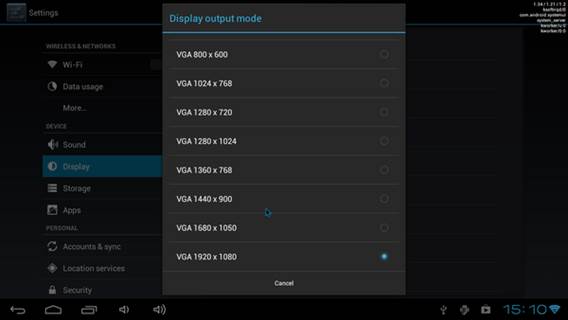Android on desktop computer
There’re 3 separate parts of Net’sPC2 which
can’t be found on other Android-based devices: mouse, keyboard, and external
screen. Let’s take a look how Android goes head to head with such strange
accessories.
Mouse
Apart from the general slowness and the
other performance-related problems, it’s clear that Android is still designed
for the touch-based input.
For example, in most of graphics OS that
are based on the traditional desktop computers, the decisive factors normally
gather around a main dock or menu for fast and easy control. in Jelly Bean, the
searching, app and navigating bar and the indicators sit at 4 corners of the
screen. While putting the decisive UI factors far away is a good thing when
holding the tablet with 2 hands or keeping the smartphone with one hand, this
creates lots of additional pointer movements when you’re using mouse.
This is somewhat created by Kaser using
right mouse. As Android doesn’t have contextual menus, the right mouse plays
concurrently a role as a back button on the screen. While we highly appreciate
this gesture, this also means that typing and holding is still necessary.
Tap hand hold, pretty alike the Android equivalent
of contextual menu /right click, require a click and hold when you’re
navigating Net’sPC2. This is not a big problem. But wasting more time to move
the subjects abound the screen is pretty tiring. On Kaser, you have to press
and hold then drag to move an object. In Windows, a simply click and drag are
enough.
Closing the apps and remove the
notification in Android requires a slide (or swipe or drag) on the touch screen
devices. On Net’sPC2, you need to do lots of inconvenient clicking and dragging
work tom complete these basic activities.
The last unusual thing that related to the
mouse is the most disappointed thing: highlighting. as Android is developed
around the touch-based input model, the OS deploys 2 brackets (or handle) to
highlight. After all, the fingertip is very inaccurate to choose the part of
the text correctly. Though Kaser has suitably precise pointing device, you’re
still forced to use the highlighting brackets. In fact, first you need to click
and hold to bring the brackets, then slide each bracket to the top and the end
of the desired area. After all, this is a tortuous way to do a very simple
thing on PC.
If you consider the problems individually,
no problem is important. However, combining together, they adds lots of
additional mouse gestures that surpass what you need to do in any large desktop
computer OS.
`
However,
combining together, they adds lots of additional mouse gestures that surpass
what you need to do in any large desktop computer OS.
Keyboard
Unlike the mouse, the keyboard is actually
no problem to Android. Smartphones with physical keyboards have appeared as
long as Android itself. Though it’s still low, this of course is due to the
overall performance of the product, not Android or keyboard (though it may be
weak).
Screen
The 3rd huge difference between Net’sPC2
and the Android handsets is the use of external screen. Normally, anything that
prefers Android comes with built-in touch screen, which means fixed res. It’s
interesting that YF810-8G offers the support for many resolutions. While we
can’t capture a screenshot including HDMI settings, if you scroll up, you will
find the options for 480i, 480p, 720i, 720p, 1,080i, and 1,080p. However, not
all of these choices are valid. We will explain later.

The
3rd huge difference between Net’sPC2 and the Android handsets is the
use of external screen.
When choosing 1,080p (VGA or HDMI), we
receive fresher images on the natural 1,080p screen. Unfortunately, as Android doesn’t
work on the multi-window screen interface, you don’t have the benefits of much
screen space. It’s clear that you can choose between small, normal, big and
enormous font sizes, but the icons, bar and the other factors on the screen
don’t change, this means that you’re stuck with the oversized icons, even on a
large desktop computer screen, regardless of the screen res.
While Android is not an optimal OS for
mouse input or large screen output, let’s see how this ARM-based Nettop
compares in terms of performance with the Android handsets having the same
price and the basic x86-based PC.